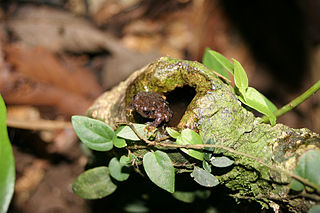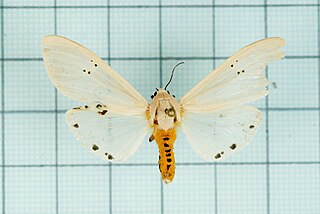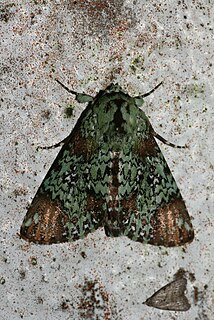
Metaphrynella sundana is a species of frog in the family Microhylidae. It is endemic to Borneo and found in Brunei, Indonesia, and Malaysia.

Ugia is a genus of moths in the family Erebidae erected by Francis Walker in 1858.

Cephena is a genus of moths of the family Erebidae. The genus was erected by Frederic Moore in 1882.

Egnasia is a genus of moths of the family Erebidae. The genus was first described by Francis Walker in 1859.
Malagonia is a genus of moths of the family Erebidae. The genus was erected by George Hampson in 1926.

Phalera sundana is a moth of the family Notodontidae. It is found in Sundaland, including Bali and Mindanao.

The Erebinae are a subfamily of moths in the family Erebidae erected by William Elford Leach in 1815. Erebine moths are found on all continents except Antarctica, but reach their greatest diversity in the tropics. While the exact number of species belonging to the Erebinae is not known, the subfamily is estimated to include around 10,000 species. Some well-known Erebinae include underwing moths (Catocala) and witch moths (Thermesiini). Many of the species in the subfamily have medium to large wingspans, up to nearly 30 cm in the white witch moth, which has the widest wingspan of all Lepidoptera. Erebine caterpillars feed on a broad range of plants; many species feed on grasses and legumes, and a few are pests of castor bean, sugarcane, rice, as well as pistachios and blackberries.

Creatonotos transiens is a moth of the family Erebidae. The species was first described in Western literature by Francis Walker in 1855.
Teleclita is a genus of moths in the family Notodontidae. The genus was described by Turner in 1903.

Ugia transversa is a species of moth in the family Erebidae first described by Frederic Moore in 1882. It is found from the north-eastern Himalayas to southern China.

Ugia disjungens is a species of moth in the family Erebidae. It is found in Thailand, Malaysia and Singapore and on Borneo. The habitat mostly consists of lowland forests, but specimens have been taken up to altitudes of 1,000 meters.
Ugia egcarsia is a species of moth in the family Erebidae. It is found in Angola.

Ugia eugrapha is a species of moth in the family Erebidae first described by Charles Swinhoe in 1907. It is found in Indonesia and Thailand.
Ugia geometroides is a species of moth in the family Erebidae. It is found in Gabon.
Ugia hecate is a species of moth in the family Erebidae. It is found in Gabon.
Ugia serrilinea is a species of moth in the family Erebidae. It is found on Borneo, Peninsular Malaysia and in Thailand and Indonesia. The habitat consists of lowland forests, including heath forests.
Ugia signifera is a species of moth in the family Erebidae. It is found in Indonesia (Sumatra) and on Borneo and Peninsular Malaysia. The species is found in various lowland habitats, ranging from forested areas to disturbed areas and coastal vegetation.
Ugia insuspecta is a species of moth in the family Erebidae. It is found in China, where it has been recorded from Hong Kong.
Ugia viridior is a species of moth in the family Erebidae. It is found on Sumatra and Borneo and in Singapore. The habitat consists of lowland forests.

Donda is a genus of moths of the family Erebidae. The genus was erected by Frederic Moore in 1882.










